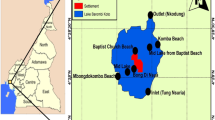Abstract
Uptake and biliary excretion of metals were studied in rainbow trout, Oncorhynchus mykiss, exposed through spiked sediment to a mixture of seven heavy metals. Metal concentrations and toxicity of bile and blood plasma were used as indicators of exposure. Among the seven metals (Cd, Cr, Cu, Hg, Ni, Pb, and Zn) only three (Cu, Hg, and Pb) were concentrated in the bile (bile-plasma ratio >1). Bile-plasma ratios in the rainbow trout were similar to those found in rats for Cu and Hg. Daphnia magna bioassays were used to determine toxicity of bile and blood plasma in the same trout. Toxicity of bile and blood plasma increased after treatment with acid. An analysis of variance (ANOVA) showed that toxicity of bile and blood plasma to D. magna in metal-exposed trout was significantly correlated with (1) bile and blood plasma test concentration, (2) acid treatment of bile and blood plasma (hydrolysis of metal-plasma and metal-bile complexes) and (3) sediment concentration of metals during exposure of trout. In order to significantly detect the magnitude of the exposure to a xenobiotic the biomarker must respond in a dose- or time-dependent manner. Therefore, the potential use of bile toxicity as a biomarker of heavy metal exposure in fish is probably limited by the low bioconcentration of many of these toxicants in bile.
Similar content being viewed by others
References
AndréassonM. & G.Dave, 1994. Toxicity of bile from fish exposed to PCP-spiked sediment. Aquat. Toxicol. 30: 171–182.
CikrtM., 1972. Biliary excretion of 203Hg, 64Cu, 52Mn, and 210Pb in the rat. Brit. J. Industr. Med. 29: 74–80.
CikrtM., 1989. Biliary excretion of mercury and cadmium. Arh. Hig. Rada. Toksikol. 40: 165–182.
FossiM. C., C.Leonzio & D. B.Peakall, 1994. The use of nondestructive biomarkers in the hazard assessments of vertebrate populations. In: M. C.Fossi & C.Leonzio (eds), Nondestructive Biomarkers in Vertebrates, pp. 3–33. Lewis Publishers, Boca Raton, Ann Arbor, London, Tokyo.
FörlinL. & C. A.Wachtmeister, 1989. Fish bile analysis for monitoring of low concentrations of polar xenobiotics in water. In: Landner (ed.), Chemicals in the Aquatic Environment, pp. 150–164. Springer Verlag, Berlin Heidelberg.
HuggettR. J., R. A.Kimerle, P. M.MehrleJr. & H. L.Bergman, 1992. Biomarkers, Biochemical, Physiological, and Histological Markers of Anthropogenic Stress. The SETAC Special Publication Series, Lewis Publishers, Chelsea, 337 pp.
HunnJ. B. & J. L.Allen, 1974. Movement of drugs across the gills of fishes. Annu. Rev. Pharmacol. 14: 47–55.
ISO (International Organization for Standardization), 1982. Water quality — determination of the inhibition of the mobility of Daphnia magna Straus (Cladocera, Crustacea). 6352, 15 pp.
IyengarV., G. J.Brewer, R. D.Dick & C.Owyang, 1988. Studies of choleocystokinin-stimulated biliary secretions reveal a high molecular weight copper-binding substance in normal subjects that is absent in patients with Wilson's disease. J. Lab. Clin. Med. 111: 267–274.
KlaassenC. D., 1976. Biliary excretion of metals. Drug Metabolism Reviews 5: 165–196.
LechJ. J., S. K.Pepple & C. N.Statham, 1973. File bile analysis: A possible aid in monitoring water quality. Toxicol. Appl. Pharmacol. 25: 430–434.
MillbumP., R. L.Smith & R. T.William, 1967. Biliary excretion of foreign compounds. Biphenyl, stilbestrol and phenolphthalein in the rat: molecular weight, polarity and metabolism as factors in biliary excretion. Biochem. J. 105: 1275–1281.
SorensenE. M. B., R. E.Henry & R.Ramirez-Mitchell, 1979. Arsenic accumulation, tissue distribution and cytotoxicity in teleosts following indirect aqueous exposures. Bull. Environm. Contam. Toxicol. 21: 162–169.
StathamC. N., M. J.MelanconJr & J. J.Lech, 1976. Bioconcentration of xenobiotics in trout bile: A proposed monitoring aid for some waterborne chemicals. Science 193: 680–681.
Swedish Environmental Protection Agency, 1990. Public Advice 90.4. Bedömningsgrunder för sjöar och vattendrag. ISBN 91-620-0042-X.
WachtmeisterC. A., L.Förlin, K. C.Arnoldsson & J.Larsson, 1991. Fish bile as a tool for monitoring aquatic pollutants: studies with radioactively labeled 4,5,6-Trichloroguaiacol. Chemosphere 23: 39–46.
Author information
Authors and Affiliations
Rights and permissions
About this article
Cite this article
Andréasson, M., Dave, G. Transfer of heavy metals from sediment to fish, and their biliary excretion. Journal of Aquatic Ecosystem Health 4, 221–230 (1995). https://doi.org/10.1007/BF00118002
Received:
Accepted:
Issue Date:
DOI: https://doi.org/10.1007/BF00118002




